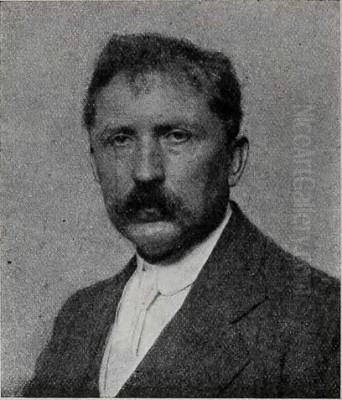
Giuseppe Casciaro stands as a significant figure in Italian art history, particularly renowned for his evocative landscape paintings that capture the unique light and atmosphere of Naples and its surrounding regions. Born in 1863 and active through the late nineteenth and early twentieth centuries until his death in 1945, Casciaro bridged the gap between traditional Neapolitan painting and the burgeoning influence of modern European art movements, most notably Impressionism. His dedication to depicting the natural beauty he observed, combined with his technical skill and sensitivity to light, cemented his reputation as a master chronicler of the southern Italian landscape.
Early Life and Artistic Formation
Giuseppe Casciaro was born on March 9, 1863, in Ortelle, a small town in the province of Lecce, part of the Salento region in southern Italy. Drawn to art from a young age, he eventually moved to Naples, the vibrant cultural capital of Southern Italy, to pursue formal artistic training. This move proved pivotal, immersing him in a rich artistic environment that would shape his entire career.
He enrolled at the prestigious Naples Institute of Fine Arts (Istituto di Belle Arti di Napoli), a crucible of artistic talent and innovation at the time. Here, he had the invaluable opportunity to study under some of the leading figures of Neapolitan painting. His most influential teachers included Domenico Morelli, a dominant force known for his historical and religious subjects rendered with dramatic realism and vibrant color, and Filippo Palizzi, celebrated for his realistic depictions of animals and rural life, emphasizing truthfulness to nature. Another instructor who likely contributed to his education was Stanislao Lista.
During these formative years, Casciaro also absorbed the influence of earlier Neapolitan landscape traditions. The legacy of the School of Posillipo, particularly the work of Giacinto Gigante, was inescapable. Gigante and his contemporaries were known for their picturesque views of Naples and its environs, often painted en plein air (outdoors) with a focus on capturing specific light conditions and atmospheric effects, albeit within a generally Romantic framework. This local tradition provided Casciaro with a strong foundation in landscape painting and an appreciation for the direct observation of nature.
Development of Style: From Romanticism to Impressionism
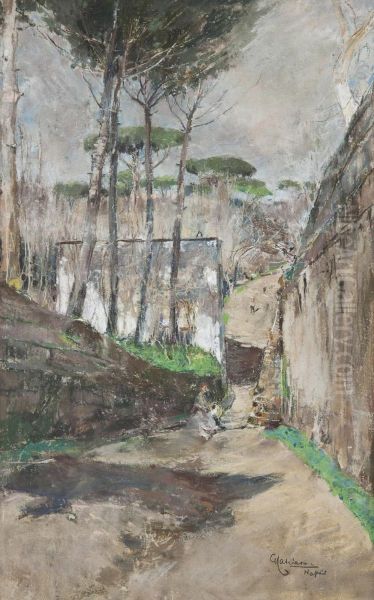
Casciaro's artistic journey reflects a gradual evolution, moving from the established norms of Neapolitan painting towards a more modern sensibility influenced by international trends. His early works show the clear imprint of his teachers and the Posillipo School, characterized by careful composition and a romanticized view of the landscape. However, he soon began to develop his own distinct voice.
A key element that came to define Casciaro's art was his profound interest in capturing the "aria" – the atmosphere, the air itself, and the way light interacts with it. He believed that conveying this intangible quality was essential to the truthfulness of a painting. This focus led him naturally towards the techniques and aesthetics associated with Impressionism, which was revolutionizing art in France during his formative years.
While it's debated how directly he encountered French Impressionism, the influence is undeniable. Naples itself was a cosmopolitan city, and artists were increasingly aware of developments elsewhere in Europe. The work of Edgar Degas, who had familial ties to Naples and spent time there, might have been known to Casciaro. Degas's innovative compositions and focus on capturing fleeting moments could have offered inspiration. Furthermore, the work of Giuseppe De Nittis, an Italian painter who achieved great success in Paris as part of the Impressionist circle, provided a closer link. De Nittis's sophisticated depictions of modern life and atmospheric cityscapes demonstrated how Impressionist techniques could be adapted.
Casciaro also likely drew inspiration from the French Barbizon School painters, such as Jean-Baptiste-Camille Corot and Théodore Rousseau. Though preceding the Impressionists, the Barbizon artists championed plein air painting and a direct, unidealized approach to landscape, emphasizing tonal harmony and the effects of light. Casciaro adopted a similar commitment to outdoor painting, using rapid brushstrokes and a brighter palette to capture the fleeting effects of sunlight, weather, and time of day on the landscapes he loved. His style became characterized by freshness, immediacy, and a remarkable ability to translate the luminosity of the Mediterranean light onto canvas.
The Neapolitan Landscape as Muse
Naples and its breathtaking surroundings became the central, enduring subject of Giuseppe Casciaro's art. He possessed an intimate knowledge and deep affection for the region, which is palpable in his paintings. He tirelessly explored and depicted the iconic Bay of Naples, the looming presence of Mount Vesuvius, the charming islands of Capri and Ischia, the picturesque Amalfi coast, and the rolling hills and verdant gardens around the city.
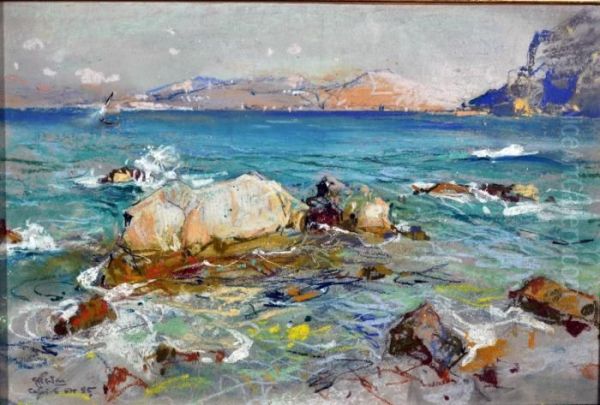
He was particularly associated with the Vomero hill, a residential area overlooking Naples where he lived for many years. His own garden and the views from Vomero provided constant inspiration. Works like Vecchio Vomero (Old Vomero) capture the character of the area, perhaps depicting rustic corners or panoramic vistas before extensive urbanization. His paintings often feature sun-drenched coastal scenes (Marina), tree-lined avenues (Viale alberato), blossoming gardens (Nel mio giardino, Aria di primavera - Air of Spring), and tranquil countryside views (Paesaggio con figure - Landscape with Figures).
Casciaro's technique was perfectly suited to his subject matter. He often worked quickly, applying paint with energetic, broken brushstrokes that conveyed the vibrancy of the scene and the shimmering quality of the light. He excelled at capturing specific moments – the haze of a summer morning, the clear light after a rain shower, the warm glow of late afternoon sun on buildings and water. His paintings are not just topographical records; they are sensory experiences, inviting the viewer to feel the warmth of the sun, the gentle sea breeze, or the cool shade of a pine grove. He painted the same locations repeatedly, exploring different light conditions and seasons, demonstrating his inexhaustible fascination with the interplay of nature and atmosphere.
Beyond Landscapes: Still Life and Pastel
While primarily celebrated as a landscape painter, Giuseppe Casciaro also demonstrated considerable skill in other genres, notably still life, and was a master of working with pastels. His still life compositions often retain a connection to the outdoors, sometimes featuring arrangements of fruit or flowers set against a landscape backdrop or bathed in natural light streaming through a window.
These still lifes share the vibrant palette and sensitivity to light found in his landscapes. They often possess a distinctly Mediterranean character, celebrating the abundance of local produce – lemons, oranges, grapes, figs – rendered with a palpable sense of texture and form. Some analyses of his later work, particularly in comparison to his son Guido Casciaro (also a painter), suggest an awareness of Neapolitan Baroque still life traditions, perhaps echoing the rich arrangements of artists like Giovanni Battista Ruoppolo or Giuseppe Recco, though Giuseppe Casciaro's primary focus remained on capturing light and atmosphere rather than meticulous detail or symbolic meaning.
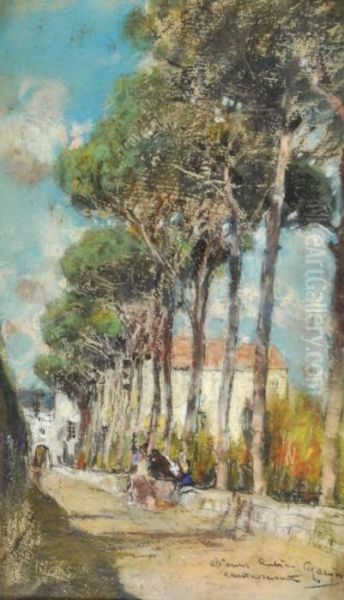
Casciaro was also exceptionally adept with pastels. This medium, with its immediacy and luminous quality, perfectly suited his artistic temperament and his desire to capture fleeting effects quickly. He used pastels for preparatory sketches en plein air, but also created highly finished works in the medium. His pastels often possess a remarkable freshness and spontaneity, showcasing his confident draftsmanship and his innate understanding of color harmony. The velvety texture of pastel allowed him to achieve subtle atmospheric effects and brilliant highlights, further enhancing the sense of light and air that permeates his work. His mastery of pastel contributed significantly to his reputation and offered another avenue for his exploration of the Neapolitan environment.
Recognition and Exhibitions
Giuseppe Casciaro achieved considerable recognition during his lifetime, both within Italy and internationally. He was a regular participant in major Italian art exhibitions, including the prestigious Venice Biennale, as well as exhibitions in Naples (at the Società Promotrice di Belle Arti), Rome, Turin, and Palermo. His talent did not go unnoticed abroad; he also exhibited his work in Paris, likely at the Salons, and other international venues.
His participation in these exhibitions often led to awards and accolades. For instance, he won silver medals at the Palermo national exhibition in 1891 and 1892. His international reputation was bolstered by successes such as winning a gold medal at the exhibition in Athens, Greece, in 1893. That same year, his work was likely included in the Italian section of the World's Columbian Exposition in Chicago, further exposing his art to an American audience.
Casciaro's paintings were sought after by collectors, including prominent figures. Notably, Queen Elena of Savoy, the wife of King Victor Emmanuel III of Italy, acquired some of his works, signifying a high level of official recognition and patronage. Today, his paintings are held in the collections of major Italian museums, including the Galleria Nazionale d'Arte Moderna e Contemporanea (GNAM) in Rome, the Galleria d'Arte Moderna (GAM) in Milan, and important Neapolitan institutions such as the Museo di Capodimonte and the Gallerie d'Italia - Palazzo Zevallos Stigliano in Naples. This presence in public collections underscores his lasting importance in the narrative of Italian art.
Casciaro and His Contemporaries
Giuseppe Casciaro was an active participant in the vibrant artistic community of Naples during a period of significant cultural ferment. He maintained close relationships with many of the leading artists and intellectuals of his time, contributing to a lively exchange of ideas and mutual support. His circle included prominent figures across different artistic disciplines.

He was friends with the celebrated sculptor Vincenzo Gemito, known for his highly realistic and emotionally charged depictions of Neapolitan street life. He also associated with painters like Antonio Mancini, whose work was characterized by thick impasto and psychological intensity; Francesco Paolo Michetti, famous for his large-scale canvases depicting the life and landscapes of the Abruzzo region; and Attilio Pratella, another renowned landscape painter who, like Casciaro, specialized in views of Naples and its bay, though often with a slightly different, perhaps more anecdotal, focus. Other contemporaries in the Neapolitan scene included painters like Vincenzo Irolli and Edoardo Dalbono.
This network of artists fostered a dynamic environment. They exhibited together, discussed artistic theories, and likely influenced one another's work. Casciaro was known not just for his own artistic output but also for his collegial nature and his willingness to support and encourage younger artists, playing a role in nurturing the next generation of Neapolitan talent. His first major solo exhibition, held in 1924 and featuring around one hundred works, would have been a significant event within this artistic milieu, showcasing the breadth of his achievement to his peers and the public. His relationships appear to have been largely collaborative and supportive, reflecting a shared passion for capturing the essence of their region, rather than being marked by intense rivalry.
Later Years and Baroque Echoes
Giuseppe Casciaro remained artistically active well into the twentieth century, continuing to paint the landscapes that had captivated him throughout his life. His style, while rooted in the Impressionistic pursuit of light and atmosphere, reportedly underwent subtle shifts in his later years. Some sources suggest that around the 1940s, his work began to exhibit a stronger sense of form and structure, occasionally described as having "Baroque echoes."
This potential late-career development might represent a synthesis of his lifelong focus on atmospheric effects with a renewed interest in compositional solidity or textural richness. It could perhaps reflect a deeper engagement with the long tradition of Neapolitan art, looking back towards the dynamism and robust forms of the seventeenth-century masters like Giovanni Battista Ruoppolo or Giuseppe Recco, whose dramatic still lifes and landscapes formed a cornerstone of the local artistic heritage. This is not to say he abandoned his Impressionistic leanings, but rather that he may have integrated these historical influences into his mature style, resulting in works that combined luminosity with a more pronounced physical presence.
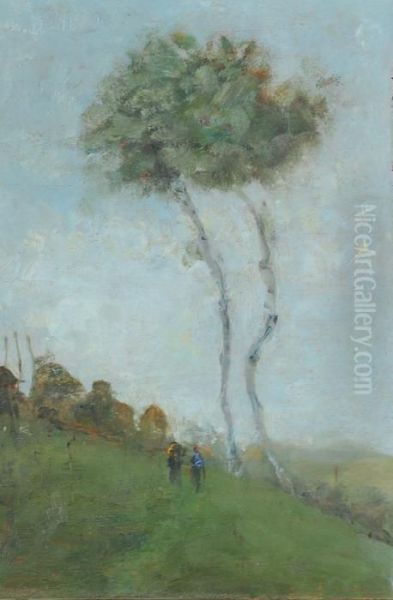
It's also worth noting the artistic activities of his son, Guido Casciaro (1900-1963), who followed in his father's footsteps as a painter. Guido's own work showed influences from his father but also engaged more explicitly with both Baroque traditions and twentieth-century movements like Metaphysical Painting (citing Giorgio de Chirico as an influence). The artistic dialogue within the family may have played a role in Giuseppe's later explorations. Giuseppe Casciaro continued working until shortly before his death in Naples in 1945, leaving behind a vast and consistent body of work dedicated to the beauty of Southern Italy.
Legacy and Art Historical Assessment
Giuseppe Casciaro's legacy is firmly established within Italian art history as a leading exponent of Neapolitan landscape painting in the late nineteenth and early twentieth centuries. His primary contribution lies in his masterful ability to capture the unique light and atmosphere of Naples and its surroundings, skillfully blending the local landscape tradition with the innovative techniques and sensibilities of Impressionism. He was a pivotal figure in transitioning Neapolitan art from the more academic or romantic styles of the mid-nineteenth century towards a more modern, light-filled aesthetic.
His dedication to plein air painting and his focus on the "aria" resulted in works that are celebrated for their freshness, spontaneity, and evocative power. He remains admired for his technical proficiency, particularly his handling of oil paint and pastel, and for the sheer consistency and passion evident throughout his long career. His paintings continue to be appreciated by collectors and the public for their beauty and their ability to transport the viewer to the sunlit coasts and gardens of Southern Italy.
Despite his historical importance and artistic merit, Casciaro's legacy is not without points of discussion. As noted by cultural heritage advocates in Italy, his birthplace in Ortelle has faced neglect, prompting calls for its restoration and transformation into a cultural center to honor his memory – a situation highlighting broader challenges in preserving artistic heritage in Italy. Furthermore, while his works appear regularly at auction, their market value sometimes seems modest relative to his standing in art history, perhaps reflecting shifting tastes or the complexities of the art market.
Nevertheless, his significance is periodically reaffirmed. The establishment of the "Giuseppe Casciaro" contemporary art prize by the Pro Loco "Ippocampo" cultural association in Ortelle in 2019 demonstrates a continued effort to keep his name and artistic spirit alive. Ultimately, Giuseppe Casciaro is remembered as a sensitive and prolific interpreter of the Neapolitan landscape, an artist who dedicated his life to capturing its ephemeral beauty and luminous essence, securing his enduring place in the story of Italian art.
Conclusion
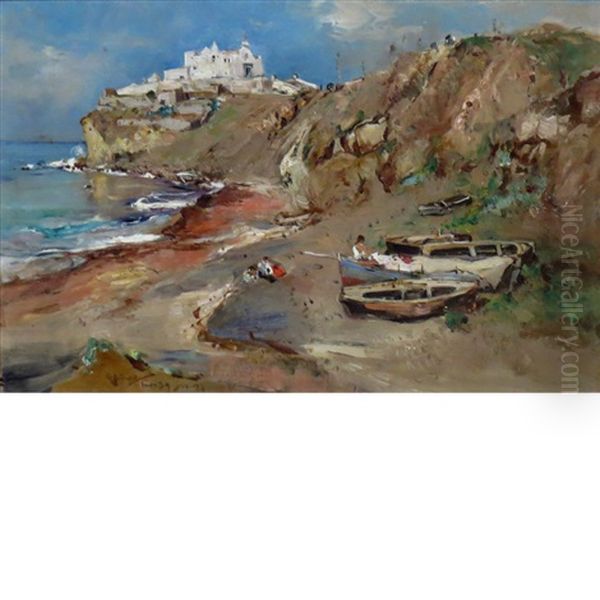
Giuseppe Casciaro devoted his artistic life to the landscapes of Naples and Southern Italy. Through his canvases and pastels, vibrant with Mediterranean light and air, he offered an enduring vision of a region renowned for its natural beauty. As a student of Naples' finest traditions and an artist receptive to the innovations of his time, he forged a distinctive style that captured the fleeting moments of nature with remarkable immediacy and sensitivity. His extensive body of work stands as a testament to his skill, his dedication, and his deep connection to place. More than just a painter of views, Casciaro was a poet of light, whose art continues to resonate with viewers, solidifying his status as a key figure in late 19th and early 20th-century Italian painting.